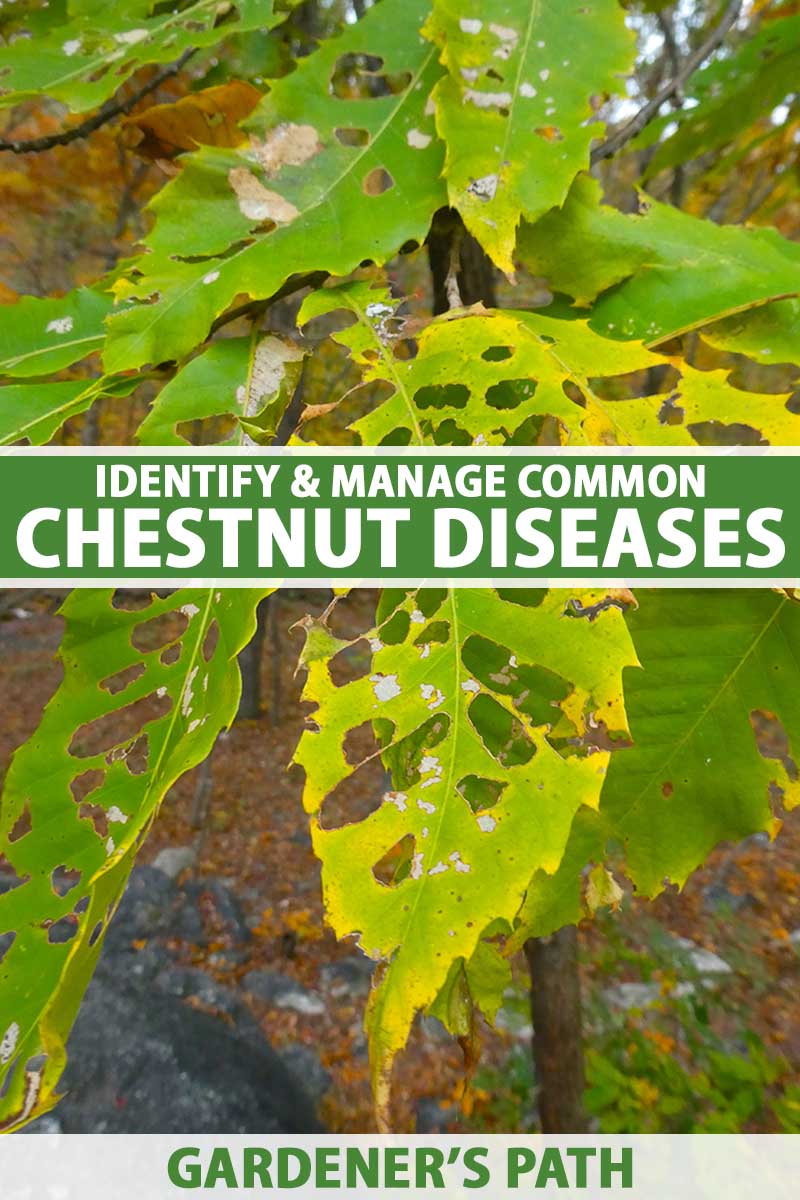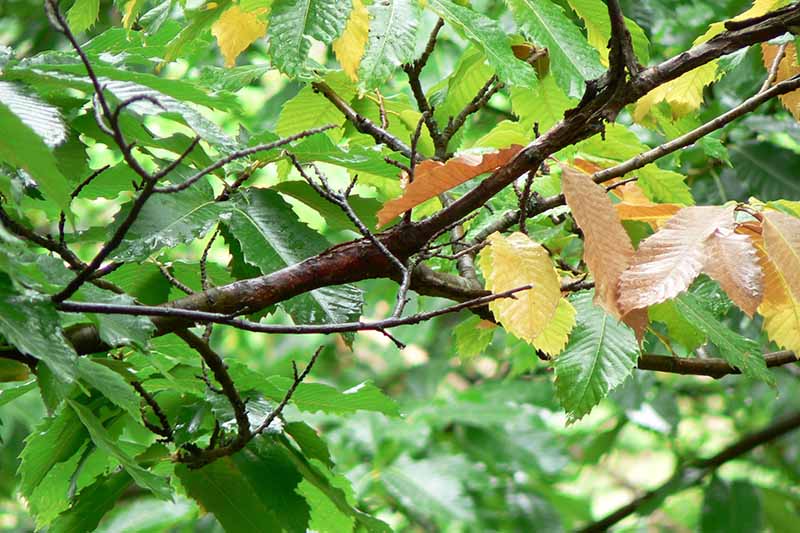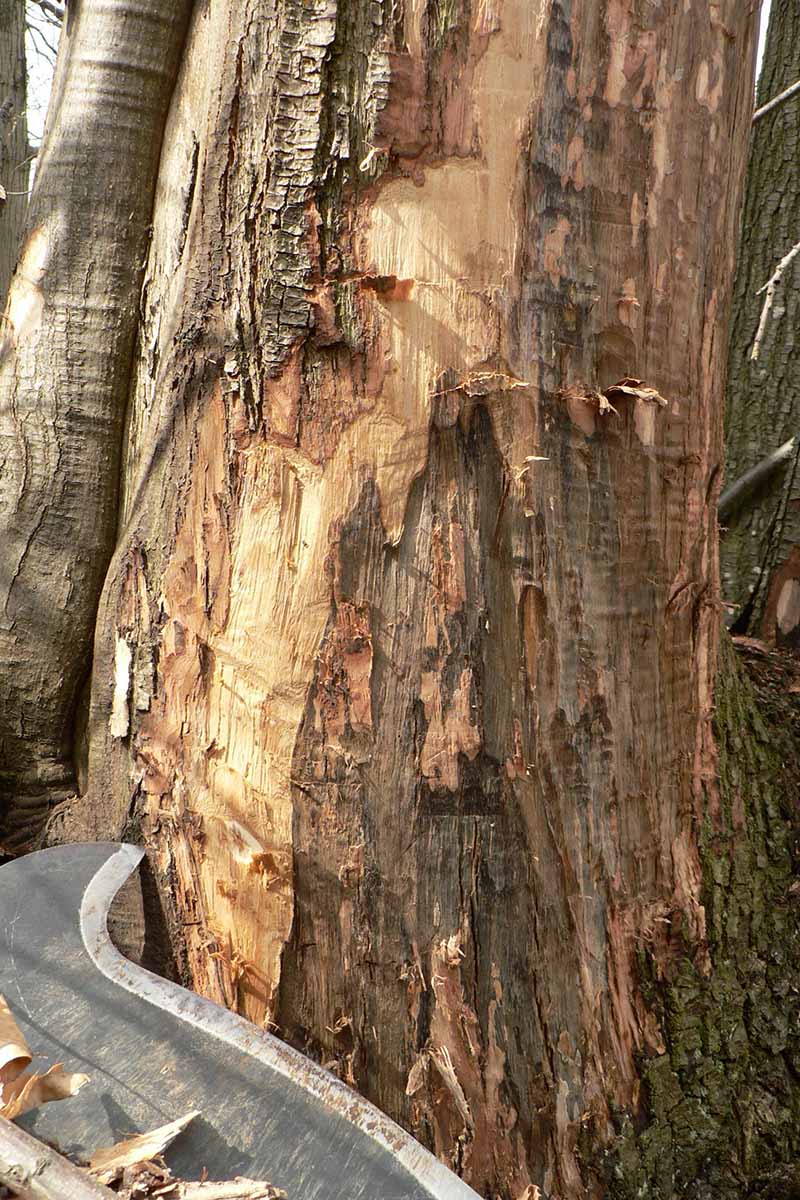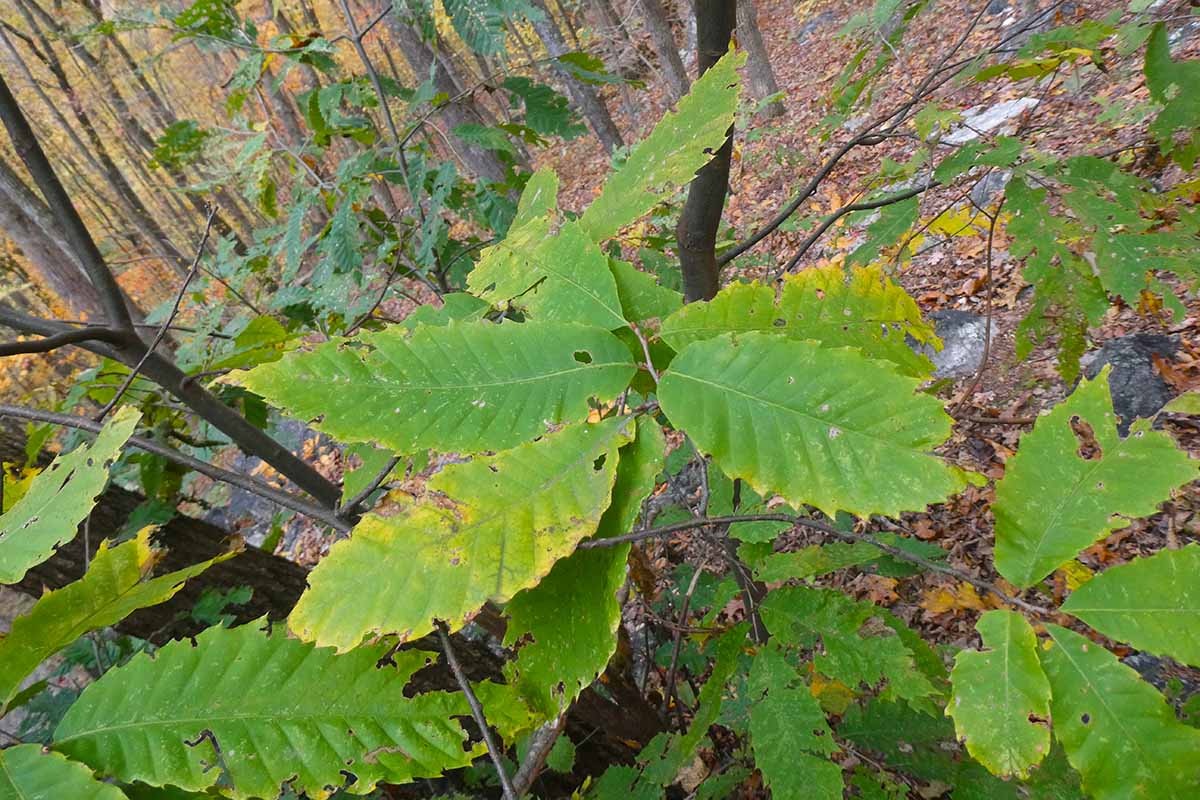Chestnuts are beautiful trees, providing shade and multi-season interest as well as edible nuts and high-quality wood. They can be productive for decades, and typically grow to impressive heights.
Unfortunately, like most plants, they are susceptible to a number of diseases. And it’s important to note that certain species may be more readily affected than others.
Even those who haven’t grown their own chestnuts before are probably familiar with the notorious blight that wiped out the American species across the US – though you may not have heard of another serious widespread epidemic that severely impacted the same species centuries before.

We link to vendors to help you find relevant products. If you buy from one of our links, we may earn a commission.
As a home gardener, it’s important to know what to be on the lookout for, and what you can do to protect your trees, cull infection, and prevent further spread. We’ll cover all of this and more.
Here’s what’s ahead:
How to Identify and Manage 5 Common Chestnut Tree Diseases
1. Anthracnose
A common disease in oak trees and other varieties of deciduous hardwoods, chestnuts may be affected by anthracnose as well.
Symptoms of infection include dry, brown, irregular spots on leaves, curling foliage, and defoliation. Twig dieback may also occur, and buds may die early in the season, exhibiting symptoms that resemble frost damage.
Small pimple-like fungal structures may be visible on the undersides of affected foliage as well, if you want to get out your magnifying glass.
Caused by Apiognomonia quercina fungi, the spores may be spread by the wind and splashing water in the spring, infecting new growth. Infections are usually the most severe on the lower and innermost branches.
Prolonged periods of wet weather are favorable to the spread of this disease, and of course, wet weather is common in many regions in the springtime.
But the most important factor is actually temperature. Anthracnose tends to be the most severe when temperatures are in the 50 to 55°F range, and less severe in temperatures of 60°F and above.
New leaves may grow back later in the season, while seriously affected trees may not recover, particularly if a springtime infection is followed by a period of drought or other stressors.
This fungus can overwinter in cankers on the branches, and in fallen leaves. Be sure to complete a thorough cleanup of the garden to remove all affected plant matter that has fallen, and prune away and burn or otherwise dispose of any dead branches and twigs to prevent further spread.
Fungicides may be applied at bud break, but this is not typically recommended for home gardeners.
2. Chestnut Blight
The American species (Castanea dentata) is highly susceptible to chestnut blight, and European chestnuts (C. sativa) and their hybrids are susceptible as well, though importing these trees to the US is rare these days. Some varieties of oak are also susceptible to infection.
There is unfortunately no available treatment for chestnut blight, a fungal disease caused by Cryphonectria parasitica. It enters the trees through wounds, often those made by insects, and the infection develops under the bark.

This disease was responsible for wiping out American chestnuts across the US in the first half of the 20th century.
Infected trees exhibit cankers, which may sometimes be confused for evidence of sunscald. Also known as chestnut bark disease, infected branches become girdled with cankers and die off quickly.
Affected limbs should be removed and destroyed, to prevent further spread.
Dead leaves will cling to infected trees rather than falling in autumn, and yellowish-brown fungal fruiting bodies may be visible around cankers and cracks in the bark.
Cankers are more apparent on younger trees, whereas they may remain hidden under the bark for some time in mature specimens.
Though trees killed by this disease will sometimes send out suckers with apparently healthy growth if the roots survive, these will eventually succumb as well.
The fungus can overwinter in the bark, and the spores can become airborne, spreading easily to new areas.
More prevalent in the eastern part of the country historically, growers out west once planted European chestnuts without much concern, though this disease is considered widespread throughout the US today.
Choosing blight-resistant varieties is recommended for home growers. Chinese chestnuts (C. mollissima) as well as Chinese-American hybrids show good resistance, and Japanese varieties (C. crenata) show some resistance as well. Be sure to purchase trees from reputable growers that are certified free of disease.
3. Nut Rot
Reportedly caused by several different species of fungi including Sclerotinia pseudotuberosa, Phomopsis castanea, Gnomoniopsis smithogilvyi, and Diaporthe castaneti, nut rot infections are most notable in Europe, Australia, and New Zealand.
A disease of harvested nuts rather than the trees themselves, rot can cause significant crop losses.
While the unshelled nuts may appear healthy, the kernels inside have a different story to tell, appearing discolored, spotted, or speckled, and soft, moldy, or rotten. In the case of severe infection, shells may show signs of mold and rot as well.
Exhibiting similar symptoms but not caused by a pathogen, when European-Japanese hybrids are pollinated by Chinese species, they may exhibit internal kernel breakdown, a physiological disorder that causes nuts to decay.
Harvesting frequently is important, to prevent the onset of nut rot, and cold storage of harvested nuts can help to prevent or delay onset.
The fungal spores can survive in nut husks (also referred to as burrs) for several years, so care should be taken to remove unharvested nuts and discarded burrs from the orchard or garden to prevent further spread.
Dispose of burrs that are infected with fungi in the trash, or burn them if this is permitted in your area. Do not put plant matter that contains disease pathogens on the compost pile.
4. Phytophthora Root Rot
Also referred to as ink disease, root rot is caused by Phytophthora water molds.
Particularly prevalent in trees planted in soil that does not drain well, with onset typically occurring in early spring, the disease pathogens can also be carried on plants purchased from nurseries.
P. cinnamomi can cause rot infections in chestnuts throughout the US.
This species was introduced on plants brought by colonists from Europe in the 1700s, and is thought to have eradicated American chestnuts from low-elevation forests in the southeast long before the introduction of chestnut blight.
Since that time, its range has expanded.

P. cambivora infections of European chestnuts and other types of hardwood trees are prevalent throughout Europe.
P. cambivora may also cause rot infections in American and Japanese chestnuts, and has been noted as the cause of rot disease in the US and Asia.
Though the infection is centered at the roots and the base of trees, infected chestnuts will show signs of wilt and branches will die back. Trees can succumb quickly, and often die.
Peeling back the bark of an infected tree would reveal black or brown necrotic tissue. Growers refer to this as the “flame” because it appears as if their trees have been scorched.
Since the oomycetes can remain in the soil for several years, do not replant chestnuts in the same location if one succumbs to root rot. Chinese chestnuts are resistant to this pathogen, but not immune.
5. Sudden Oak Death
Another devastating disease caused by Phytophthora water molds, sudden oak death affects oaks and their relatives, as well as a variety of other types of trees and understory plants including rhododendrons and camellias.
A then-unidentified infection was reported to be plaguing trees in Marin County, California in 1995, and deadly sudden oak death infections were first noted and identified in the forests of Oregon in 2001.
Since then, infected nursery stock has been found in at least 25 states in the US.

Also known as Ramorum disease. P. ramorum favors wet conditions. Temperatures above 80 or below 59°F slow its growth, but springtime temperatures in the upper 60s usually hit right there in this fungus-like organism’s sweet spot.
Cankers on the bark of infected trees often ooze with a black or reddish liquid, leaves exhibit spotting, and twigs die back. If you suspect that your trees are infected, contact your local agricultural extension specialist.
This disease can often be confused for ailments caused by other pathogens.
The water molds can be spread via infected soil, and wind-blown or splashing rain. Do not replant susceptible trees or shrubs in the same place where another plant has succumbed to this disease.
Chestnuts are under quarantine by the USDA to prevent further spread of this pathogen, and deliveries of seedlings and saplings from nurseries outside your state may not be available in certain areas.
Be sure to follow any quarantine regulations that are active in your region to prevent potential spread.
Be on the Lookout to Keep Chestnuts Healthy
To prevent disease in your orchard, it’s important to stay on top of proper care practices, and be on the lookout for signs of a problem.
Ensure that they are planted in soil with good drainage, and prune to improve airflow and allow sunlight to penetrate the canopy.
If you’re planting chestnuts for the first time, or acquiring more to add to your orchard, look for disease-resistant varieties, and give your business to nurseries that ensure disease-free seed stock and saplings.
The spread of many pathogens is particularly common when conditions are rainy and cool in the spring, and you can sometimes nip an infection in the bud via pruning or thorough garden cleanup at the end of the season.

It’s sad but true that the American chestnut has been wiped out more than once in the US thanks to disease, though horticulturists are making efforts to save this noble tree, and development efforts are underway to produce new hybrids and cultivars that produce tasty harvests while resisting disease. Thanks in large part to these efforts, you can grow your own chestnuts at home today!
Have you encountered disease in your orchard? Do you have any stories or questions to share? We love hearing from you! Please post your messages and share photos in the comments below.
And for more information about growing your own nut trees at home, read these guides next:
Hello I have a problem with my chestnut trees, i tried downloading a photo but it doesent seem to work, can you help or send me a link to send photo regards
Norman Evans
Hi Norman, sure – we are happy to help. When you try to attach a photo using the little paper clip in the right corner of the dialog box, do you get an error?
For now, you’re welcome to describe the issue in detail and we’ll see if we can help.
I started some nuts from European chestnuts this spring. The nuts started fine and grew about 8 to 10 inches tall. Now the leaves are turning brown and falling off. Need a little help
Starting with seed can be a time-consuming process, and sometimes the seeds themselves may be infected with fungal pathogens. I would advise against continuing to cultivate any seedlings that show signs of disease like you’ve described at this young stage.
We have four pink flowering chestnut trees that are about 20 years old. We’ve had nuts every year but this year there are none, even though they flowered normally in the spring. What can cause this?
Is this a horse chestnut? I don’t think I know of an edible chestnut that produces pink flowers.
Even though the trees flowered, did you have a late freeze that may have affected pollination and fruit set? Cold weather late in the season can impact nut production.
I found these growths on the skin of the nuts this year. Please see attached photo. It just seems to affect one tree in a group of 4 where I live in Hertfordshire. These growths are close to the “tassle'” in the nuts in this picture.
Do you have any idea of the cause or remedies. So far it doesn’t seem to affect the nut inside. Not all nuts are affected.
Though rare in the UK, I wonder if this might be brown rot. I recommend sending samples to your local agricultural office for testing if this is available in your area, to diagnose the problem. Fungal pathogens often live on fallen husks and plant debris, so be sure to practice good orchard hygiene to clean up and discard all fallen nuts and detritus to prevent further spread. Processed nuts can also be frozen to prevent or slow fungal development.
My chestnut trees leaves are full of holes and curling. Why is that?
Hey Rocco, it sounds like your tree might have leaf spot, caused by the fungus Marssonina ochroleuca.
This isn’t considered fatal and arborists recommend no treatment – instead, let the problem run its course and next year your tree should be back to normal.
But it would be helpful if you could attach a photo to make sure.
Thanks for asking!
Good afternoon everyone , can anyone advise what’s going on with my chestnut tree . We had leaves drop off last year well before autumn and no conkers for the last two years yet previously we’ve had many .
A tree surgeon said it’s starting to look distressed , can anyone shed some light ? Thank you
Hi Jemma, it looks like your tree could be suffering from chestnut leaf blotch from the fungus Phyllosticta paviae, which causes brown blotches with yellow margins.
Wet spring weather is often responsible for spreading the spores.
And although it’s unsightly, it doesn’t usually cause serious damage.
Spraying isn’t usually recommended but raking and burning the leaves in fall can help prevent its spread the following year.
Thanks for your question.
I find it impossible to understand why a cure has not been found for the chestnut tree. There is nothing that hasn’t been conquered by science. Why hasn’t the blight? I see infected trees everywhere and it would seem easy to spray or brush on a medicine .
Hi Michael, I wish we could find something. It’s awful, devastating, and has cost farmers millions of dollars. We’ve also lost native trees and destroyed the American chestnut industry. Maybe someday science will find a solution. While they’re at it, I hope they find a solution for cancer!
i have a large chestnut oak tree. showing signs of brown or rust color trails on bark.
i have looked and most sites say nothing you can do once this happens. Chesapeake, Virginia
Hi there, I’m not really able to see what you’re talking about. If you could provide me with a closer picture of the area in question, I could better assist you.